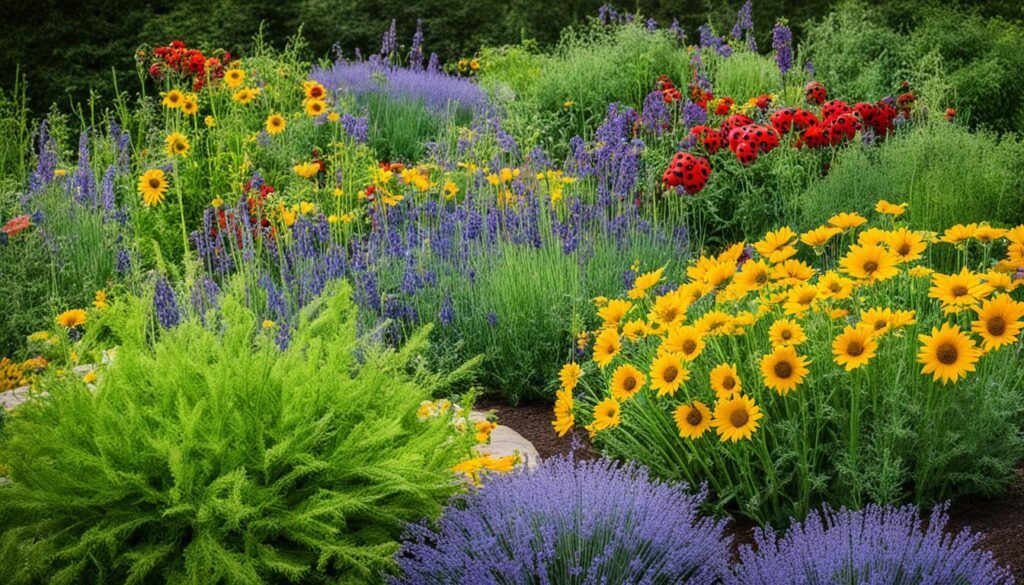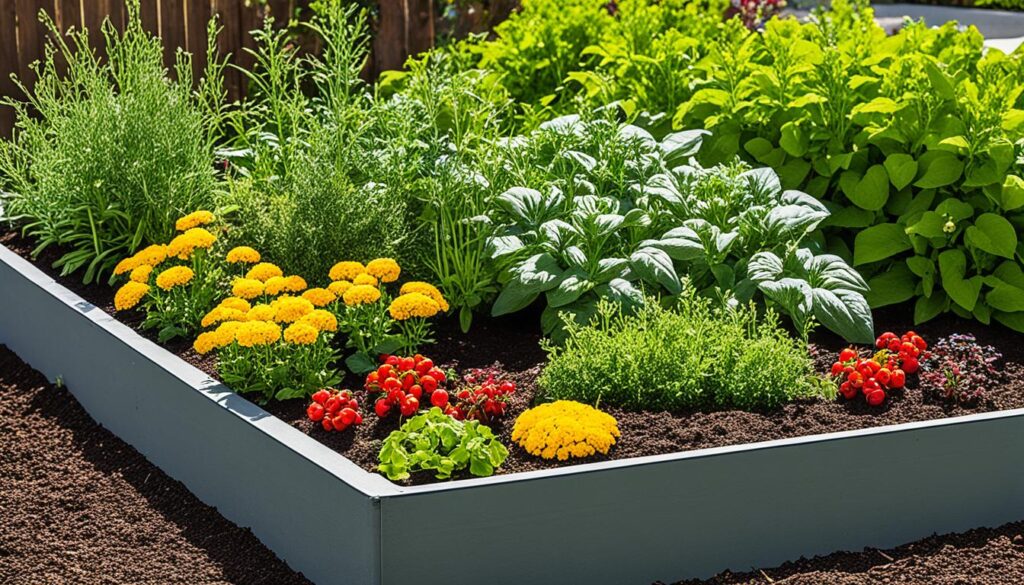Creating a Balanced Garden Ecosystem with Companion Planting
Ever wondered how ancient gardeners got such great harvests? The secret is in companion planting. This method uses the natural links between plants to make gardens thrive. We’ll dive into the ancient wisdom of companion planting and show how it can make your garden a lush, self-sustaining place.
Key Takeaways
- Discover the ancient roots of companion planting and how it can benefit your modern garden
- Learn how to leverage natural pest control and enhance biodiversity using strategic plant pairings
- Optimize your garden’s space and yield through thoughtful companion planting techniques
- Attract beneficial insects, pollinators, and wildlife to create a thriving garden ecosystem
- Explore proven companion planting combinations for soil health, visual appeal, and long-term success
Imagine a garden that thrives without harmful pesticides or too much work. Companion planting is the answer. By using this method, you can make your garden a lush, thriving space that works with nature. It’s time to bring this ancient wisdom into your modern garden.
The Ancient Wisdom of Companion Planting
Companion planting has been around for a long time, going back to ancient times. It’s based on the “Three Sisters” method from Indigenous American farming. This method uses corn, beans, and squash together.
Tracing the Origins: From Ancient Civilizations to Modern Gardens
For centuries, farmers used companion planting in many cultures. The early cottage gardens were designed to help plants work together. They picked plants that helped each other out, like fighting pests or sharing nutrients.
The Three Sisters: An Indigenous Tradition of Symbiotic Planting
The “Three Sisters” method is a key part of Indigenous American farming, going back over 3,000 years. It’s about growing corn, beans, and squash together. Corn helps the beans grow by providing a structure for them to climb on.
Beans are great at making the soil richer with nitrogen. Squash spreads out and covers the ground, keeping it moist, stopping weeds, and keeping the soil cool.
“The Three Sisters method embodies a harmonious relationship between three staple crops: corn, beans, and squash.”
This old way of planting is still guiding today’s gardeners. They aim to mimic the natural balance found in nature.
Unleashing Nature’s Power: Companion Planting Benefits
Companion planting is a natural way to control pests and boost garden diversity. By pairing certain plants, you can keep pests away and draw in helpful insects. This creates a balanced and thriving garden ecosystem.
Natural Pest Control: Repelling Pests with Strategic Plant Pairings
Some flowers, like nasturtiums and marigolds, have strong smells that pests don’t like. These plants can keep aphids, beetles, and other pests away. Adding them to your garden helps you avoid harsh chemicals and keeps your garden healthy.
Enhancing Biodiversity: Attracting Beneficial Insects and Wildlife
Having different plants in your garden improves soil health and fights pests and diseases. By choosing a variety of flowers, you’ll draw in helpful insects, birds, and wildlife. Flowers like bee balm and echinacea help bees and butterflies, making sure plants can reproduce well. This makes your garden stronger and healthier.
“By incorporating companion plants, you can create a natural pest control system while attracting a diverse array of beneficial insects and wildlife, resulting in a thriving and balanced garden ecosystem.”
Companion planting is a green and complete way to garden. It uses nature to control pests, increase diversity, and improve plant health. With the right plant combinations, your garden can be full of life and self-sustaining.
Optimizing Space and Yield with Companion Planting
Root crops like radishes, carrots, and beets are great for companion planting. They grow well together and can be harvested at different times. This makes them perfect for a busy garden.
By planting these vegetables together, gardeners can use space wisely and get fresh produce all season. It’s a smart way to make the most out of your garden.
Root Crop Companions: Maximizing Space and Harvest Potential
Radishes, carrots, and beets work well together. Radishes grow fast and can be planted between the slower-growing carrots and beets. This way, you use space well and can pick radishes early.
As you pick the radishes, the carrots and beets have room to grow. This method makes your garden more efficient and productive.
But there’s more to companion planting for root crops. Adding plants like dill, lettuce, beans, and cucumbers between them makes your garden better. It uses space well and makes your garden more diverse and productive.
“By embracing the principles of companion planting, gardeners can transform their root crop beds into veritable oases of productivity and efficiency.”
Success comes from knowing how each root crop grows and when it’s ready to be picked. With some planning and creativity, you can use companion planting to make your garden better. You’ll get more from your space and enjoy a bountiful harvest.
Attracting Beneficial Insects: Pollinators and Predators
Creating a great garden is not just about growing plants. It’s also about inviting beneficial insects to your garden. These insects are key to a balanced garden. They help pollinate plants and eat pests.
Cover crops like clover and buckwheat are great for your garden. They offer homes for insects and improve the soil. Clover fixes nitrogen and shelters insects, making the soil richer. Buckwheat grows fast and has many small flowers. These attract beneficial beetles, lacewings, and wasps.
To make your garden a haven for pollinators, plant a variety of flowers. Think about adding lavender, borage, calendula, and sunflowers. These flowers will draw in bees and butterflies, helping your garden grow well.
“Attracting beneficial insects is a key component in creating a balanced garden ecosystem. By providing the right companion plants, you can harness the power of nature to reduce pests and promote healthy plant growth.”
A garden with many different plants is a healthy garden. By choosing plants that attract beneficial insects, you’ll create a lush, productive, and balanced garden.

| Companion Plant | Insects Attracted | Benefits |
|---|---|---|
| Clover | Various predatory insects, including beetles and lacewings | Nitrogen fixation, soil enrichment, habitat provision |
| Buckwheat | Parasitic wasps, hover flies, ladybugs | Fast-growing, abundant small flowers, habitat for beneficial insects |
| Lavender, Borage, Calendula, Sunflowers | Bees, butterflies, hummingbirds | Attractive to a wide range of pollinators, ensuring healthy harvests |
Embracing Diversity: Flower Companions for a Vibrant Garden
Creating a beautiful garden starts with picking flowers that look good together. By using flower companion planting, you can make a garden that looks great all season. This approach makes your garden diverse and thriving.
Complementary Colors and Bloom Times for Visual Appeal
Choosing the right colors for your flowers is key to a stunning garden. Pairs like blue and orange or purple and yellow make your garden pop. Mixing different shades within these pairs adds depth and interest.
It’s also important to plan when your flowers will bloom. Mixing early, mid, and late bloomers ensures your garden stays colorful all season. This approach also feeds pollinators and keeps your garden beautiful over time.
Annual and Perennial Flower Pairings for Continuous Beauty
Knowing the difference between annual and perennial flowers helps plan a beautiful, easy garden. Annuals bloom for one season and need replanting each year. Perennials come back every year, spreading and becoming a garden staple.
Using both annual and perennial flower companions means your garden looks great with less work. This mix offers continuous color and texture. It attracts pollinators and delights everyone who sees it.
“The true essence of a garden lies in its ability to captivate the senses and nourish the soul. By embracing the diversity of flower companions, we can cultivate a sanctuary that reflects the ever-changing beauty of nature.”
balanced garden ecosystem companion planting
Companion planting is a great way to make your garden better. Some plants help improve the soil, making it healthier for all plants around them. For example, marigolds can keep pests away and make the soil healthier Borage adds important minerals to the soil and has deep roots that help the soil structure. Comfrey pulls nutrients from deep in the soil and releases them as it breaks down, making the soil richer. Adding these plants helps create a garden that’s full of life and healthy soil.
Encouraging Biodiversity: Creating a Haven for Wildlife
Having many different plants in your garden makes the soil healthier and keeps pests away. By planting flowers that attract insects, birds, and other wildlife, you make your garden a better place for them. Flowers like bee balm and echinacea help bees and butterflies, which is good for your plants and your garden. This variety makes your garden stronger and more able to fight off diseases and pests on its own. Adding things like bee hotels and water sources keeps the good bugs in your garden.
| Companion Plants for Soil Health | Benefits |
|---|---|
| Marigolds | Suppress nematodes, improve soil health |
| Borage | Add trace minerals, improve soil structure |
| Comfrey | Draw nutrients from deep in the soil, enrich upper soil layers |
“By incorporating a diverse mix of plants, gardeners can create a thriving, balanced garden ecosystem that supports a wide range of beneficial species.”
Companion Planting Combinations for Success
In sustainable gardening, pairing plants wisely can bring many benefits. By matching nitrogen-fixing plant companions with heavy feeders, and pest-repellent companion plants with pest-attracting trap crops, you can make your garden thrive naturally.
Nitrogen-Fixing Plants and Heavy Feeders
Legumes like peas, beans, or clover fix nitrogen in the soil. They grow well with heavy feeders like corn, tomatoes, or cabbage. These legumes add nitrogen, helping nearby plants grow strong. This nutrient-sharing plant pairing keeps soil fertile and cuts down on synthetic fertilizers.
Pest-Repellent and Pest-Attracting Plant Pairs
Plants with strong smells, like marigolds, garlic, or onions, keep pests away. They act as pest-repellent companion plants. Near carrots or potatoes, they protect against aphids or nematodes. Also, plants like dill or fennel draw pests away from other plants, acting as pest-attracting trap crops.
This mix of pest-repellent and pest-attracting plants helps keep your garden balanced. It uses natural pest management to keep pests away.
Using these companion planting methods, you can make your garden strong and self-sustaining. It will need little care and support the health and productivity of your plants for a long time.
Planning and Implementing Companion Planting
Learning about companion planting takes some planning. Use companion planting resources and gardening guides to make your garden thrive. These guides, like The Old Farmer’s Almanac Companion Planting Guide and Rodale’s Basic Organic Gardening, share tips on pairing plants for the best results.
Don’t just stop there. Contact your local cooperative extension services for advice from gardening pros. They know which plants work well together in your area. They can help with companion plant placement and garden layout design to make your garden better.
Designing Your Garden Layout for Optimal Plant Interactions
Arranging your garden right is key to a great companion planting setup. Think about how tall the plants are, what light they need, and what soil they like. Putting plants together that work well can make better growing conditions for everyone. Use a mix of plants, from low-growing ones to tall ones, to make your garden look good and work well.
“Companion planting is not just about growing plants side by side; it’s about creating a harmonious, symbiotic relationship that benefits the entire garden ecosystem.”
Use companion planting resources and plan your garden well. This way, you can make the most of companion planting. You’ll have a garden that’s full of life, productive, and good for the planet.

Nurturing a Thriving Garden Ecosystem
To make your garden vibrant and sustainable, watch and adapt. Keep an eye on how plants interact and your garden’s health. This helps you choose the best companion planting strategies. Regular checks let you spot and fix any issues, like adding pest-repellent plants or moving plants around.
Maintaining Balanced Plant Communities Through Observation
Watching how plants interact in your garden is key for its health. Notice how they grow, who eats them, and how strong they are. This helps you adjust your companion planting to make sure each plant does well. It keeps your ecosystem balanced.
Embracing Sustainable Gardening Practices for Long-Term Success
Using sustainable gardening methods helps your garden last longer and be stronger. Add organic stuff to your soil to help it and the plants. Don’t use harmful pesticides and fertilizers. Go for natural ways like planting friends together and using cover crops instead. These eco-friendly choices make your garden self-sustaining and healthy for years.
| Sustainable Gardening Practices | Benefits |
|---|---|
| Incorporating organic matter | Supports soil health and biodiversity |
| Avoiding synthetic pesticides and fertilizers | Promotes a balanced, self-sustaining ecosystem |
| Implementing cover cropping | Enhances soil fertility and nutrient cycling |
Understanding your garden’s ecosystem and using sustainable gardening practices leads to a thriving garden. It will keep doing well for many years.
Conclusion
Companion planting is a great way to make your garden healthier and more productive. It helps control pests, improves soil, and adds beauty to your garden. By using companion planting, you can make your garden a thriving place.
Try new things, watch how they do, and change your plans as needed. This way, you can make the most out of your garden. Companion planting brings together different plants to create a balanced garden.
This approach helps your garden grow well and supports many kinds of life. It’s a way to make your garden better for you and the environment. Start companion planting and see how your garden changes into a beautiful, self-sustaining place.
FAQ
What is the history of companion planting?
What is the “Three Sisters” companion planting method?
How does companion planting help with natural pest control?
How can companion planting improve soil health and biodiversity?
How can companion planting help with space and yield optimization?
How can companion planting enhance the visual appeal of a garden?
How can companion planting improve soil quality?
What are some effective companion planting combinations?
Where can I find reliable resources for companion planting guidance?
How can I maintain a thriving companion planting system?
Source Links
- 10 Must-Have Blooms for Your 2025 Garden
- The Health Advantages of Gardening You Need to Know
- How to Create a Small Vegetable Garden Layout Plan: A Beginner’s Guide
- DIY Garden Projects for Small Spaces: Upcycling Ideas to Maximize Your Garden
- Watering Techniques for Small Gardens: Ensuring Your Plants Thrive
- Small Border Plants for Landscaping: Adding Beauty and Functionality to Your Garden
- Year-Round Small Space Gardening: Seasonal Planting Tips for Maximum Harvest
- Essential Tools for Small-Space Gardening: What You Really Need
- The Ultimate Guide to Container Vegetables: What to Grow in Small Spaces
- Budget-Friendly Gardening: How to Create a Thriving Garden on a Tight Budget
- How to Optimize Sunlight in Small Gardens: Tips for Better Plant Growth
- DIY Vertical Planters: Creative Ideas for Small Space Gardening
- Companion Planting for Small Vegetable Gardens: Boost Growth and Deter Pests
- Container Gardening Essentials: Choosing the Right Pots, Soil, and Plants
- Vertical Gardening Techniques: Maximizing Your Small Space with Climbers and Vines
- How to Build a Raised Bed Garden in a Small Backyard: Step-by-Step Guide
- The Best Vegetables for Small-Space Gardens: High-Yield Varieties You Need to Grow
- Smart Vegetable Garden Layouts for Small Spaces: Maximizing Your Green Thumb in Compact Areas
- 40. Best Practices for Managing a Sustainable Garden Year-Round
- Building a Wildlife Pond for Biodiversity
- Advanced Techniques in Sustainable Gardening
- How to Create a No-Till Garden
- The Mental Health Benefits of Gardening
- Using Technology to Enhance Sustainable Gardening
- Getting Certified Organic: Steps and Benefits

Leave a Reply